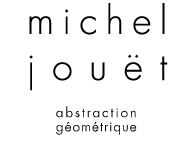L’œuvre, en premier lieu, est un tour de force conceptuel, qui procède à la fois de la « grecque » et du labyrinthe que l’esprit calculateur de Michel Jouët a projeté dans l’espace théorique d’un cube.
La contemplation de cette sculpture nous mène à tenter de saisir mentalement le programme de l’artiste qui, n’étant pas, par définition, une machine, a cependant « machiné » son oeuvre. Fait de tubes à section carrés, soudés, peints en rouge, puis vernis, ce cube tient sur trois pointes comme tiendrait – dans le registre intellectuel – un impeccable raisonnement. À cet égard, l’œuvre se présente donc comme la concrétisation (ou la transposition en 3 D) d’un algorithme : à savoir, en l’occurrence, la systématisation d’une démarche procédurale dont le principe voulait que fût réalisé, sous forme de décrochements orthonormés, un circuit quasi fermé sur lui-même.
Ce cube n’est pas rouge pour rien. Noire, en effet, l’œuvre aurait été à deux doigts de générer le malencontreux motif de la svastika, motif objectivement splendide – dont on sait que les branches pliées à angle droit réalisent la quadrature d’un cercle – mais que les Nazis ont oblitéré pour des décennies. Craignant que, sous nos cieux, cette croix ne constitue une hypo-image de sa structure, Michel Jouët a opté pour le plus rutilant des rouges industriels. Du coup, ce bloc de rigueur se met à « danser ». Apollon visité par Dionysos ? Il y a là quelque chose du Boogie Woogie de Mondrian.
Il se trouve, par ailleurs, que ce « cube » est, plastiquement parlant, le mieux abouti du monde. Comme si Michel Jouët avait – à l’instar de quelques illustres prédécesseurs (1) – réalisé le vieux rêve philosophique d’une œuvre, qui, pour mathématisée qu’elle soit, échappe cependant au formalisme pour lui-même. On veut dire que si l’invention et la réalisation de cette sculpture relèvent d’un exercice de haute école, l’œuvre porte en soi (et fatalement, sans doute) sa part de symbolisme. Qu’est-ce à dire ? Il est impossible de ne pas se référer (fût-ce de façon fugace) à ce qui, en nous, restant chaotique, demande à être démêlé puis ordonné.
Ainsi, face au cube de Michel Jouët, avons-nous la preuve que Sisyphe n’est pas toujours perdant.
(1) L’homme de Vitruve de Léonard ou La bataille de San Romano d’Ucello
Algorithme
FRESNAULT-DERUELLE Pierre 2010
The work, is first of all, a conceptual tour de force, which is a product both of Greek ideas, and the labyrinth the calculating mind of Michel Jouët has projected into the theoretical space of a cube.
Looking at this sculpture leads us to try to grasp the project of the artist, who, by definition not being a machine, has nonetheless ‘engineered’ his piece. This cube, made of square tubes, which are soldered, painted red and then varnished, stands on three points as a perfect argument would – in the realm of the intellect. In this respect the piece stands as the realization (or the 3D version) of an algorithm: that is, in this case, the conceptualization of an approach whose principle was that an almost self-enclosed circuit should be created in the form of orthonormal projections.
This cube is not red for nothing. Had it been black, the piece would have come within an inch of delivering the unfortunate symbol of the swastika, a symbol that is objectively excellent – as we know, its legs, bent at right angles, create the squaring of a circle, but for decades the Nazis have obliterated it. Fearing that, in our day, this cross might be a hypo-image of his structure, Michel Jouët opted for the shiniest of industrial reds. At a stroke this harsh mass begins to ‘dance’. Apollo visited by Dionysus? There is a suggestion of Mondrian’s Boogie Woogie.
It turns out, moreover, that this ‘cube’ is – aesthetically speaking – the best ever. It is as if Michel Jouët had, following the example of various illustrious predecessors (1) – achieved the philosophic dream of a work that, despite its mathematical nature, nonetheless escapes formalism for its own sake. By this one means that, although the design and creation of this sculpture originate from a high school exercise, the work carries within it (inevitably, no doubt) its share of symbolism. What does this mean? It is impossible not to reference (if only fleetingly) what is chaotic in ourselves, and needs to be sorted out and put into order.
Thus, when we see Michel Jouët’s cube, we have proof that Sisyphus is not always defeated.
- The man of Vitruvius by Leonardo, or the Battle of San Romano by Uccello
Algorithm.
Pierre Fresnault-Deruelle – 2010
